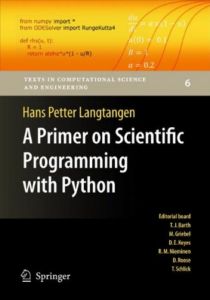The book serves as a first introduction to computer programming of scientific applications, using the high-level Python language. The exposition is example- and problem-oriented, where the applications are taken from mathematics, numerical calculus, statistics, physics, biology, and finance. The book teaches "Matlab-style" and procedural programming as well as object-oriented programming. High school mathematics is a required background, and it is advantageous to study classical and numerical one-variable calculus in parallel with reading this book. Besides learning how to program computers, the reader will also learn how to solve mathematical problems, arising in various branches of science and engineering, with the aid of numerical methods and programming. By blending programming, mathematics and scientific applications, the book lays a solid foundation for practicing computational science.
In Collection
#3744
Read It:
Yes
#3744
Read It:
Yes
|
|
||||||||||||||||
Notes
The aim of this book is to teach computer programming using examples from mathematics and the natural sciences. We have chosen to use the Python programming language because it combines remarkable power with very clean, simple, and compact syntax. Python is easy to learn and very well suited for an introduction to computer programming. Python is also quite similar to Matlab and a good language for doing mathematical computing. It is easy to combine Python with compiled languages, like Fortran, C, and C++, which are widely used languages for scientific computations. A seamless integration of Python with Java is offered by a special version of Python called Jython. The examples in this book integrate programming with applications to mathematics, physics, biology, and finance. The reader is expected to have knowledge of basic one-variable calculus as taught in mathematics-intensive programs in high schools. It is certainly an advantage to take a university calculus course in parallel, preferably containing both classical and numerical aspects of calculus. Although not strictly required, a background in high school physics makes many of the examples more meaningful. Many introductory programming books are quite compact and focus on listing functionality of a programming language. However, learning to program is learning how to think as a programmer. This book has its main focus on the thinking process, or equivalently: programming as a problem solving technique. That is why most of the pages are devoted to case studies in programming, where we define a problem and explain how to create the corresponding program. New constructions and programming styles (what we could call theory) is also usually introduced via examples. Special attention is paid to verification of programs and to finding errors. These topics are very demanding for mathematical software, because we have approximation errors possibly mixed with programming errors.
